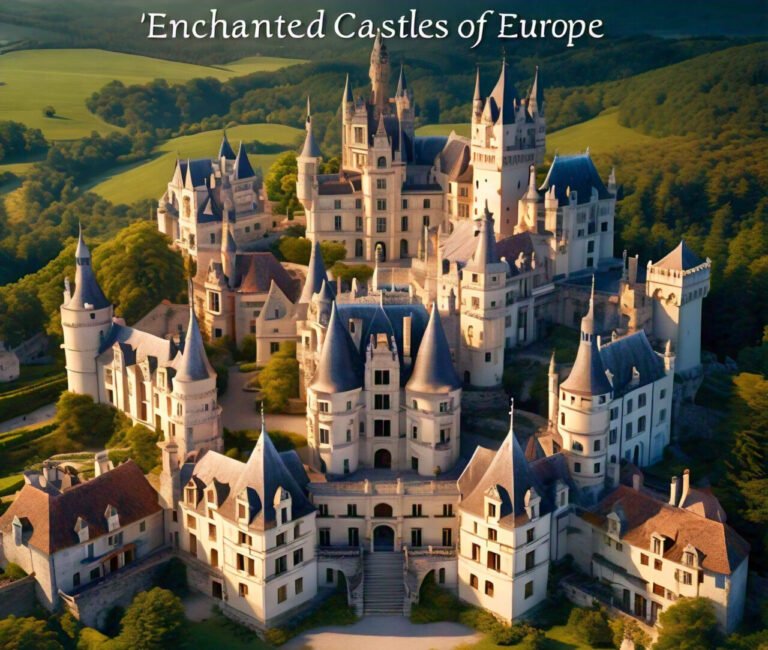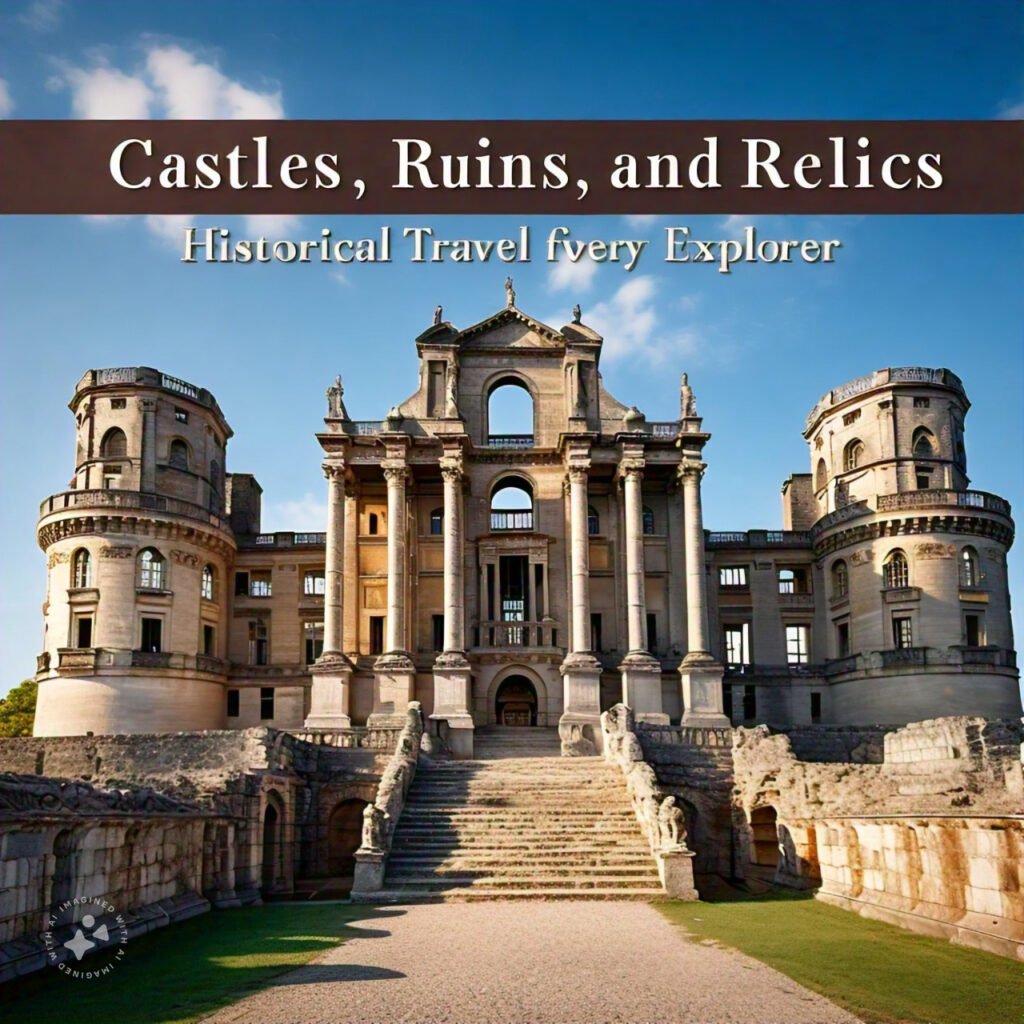Exploring the World’s Ancient Treasures: A Journey through Time and Heritage
Travel captivates the imagination, and for history enthusiasts, there’s a special allure in visiting ancient sites, where stories of bygone civilizations still echo through crumbling ruins, ancient castles, and monumental architecture. These destinations, shaped by the passage of centuries, offer travelers more than just scenic beauty—they reveal tales hidden within the layers of stone and earth, waiting to be discovered by those curious enough to venture off the beaten path.
In this journey, we’ll explore some of the most remarkable ancient sites across the globe. From Europe’s medieval castles to South America’s Inca sites, each destination promises a deep dive into the past, offering insights into the lives and legacies of our ancestors.
Enchanted Castles of Europe
Europe, often celebrated as a treasure trove of historical wonders, is home to countless ancient castles and fortresses that have witnessed centuries of history, warfare, and royal intrigue. These castles, scattered across countries like France, Scotland, and Germany, not only serve as reminders of Europe’s feudal past but also embody the timeless allure of medieval architecture and grandeur.
- France’s Loire Valley: Known as the “Garden of France,” the Loire Valley is home to some of Europe’s most enchanting castles, including Château de Chambord and Château de Chenonceau. These opulent palaces, often set against rolling vineyards, tell stories of Renaissance luxury and aristocratic lifestyles, with intricate gardens, turrets, and grand halls that transport visitors to another era.
- Edinburgh Castle, Scotland: Perched atop Castle Rock, Edinburgh Castle is a medieval marvel and a symbol of Scottish resilience. Its strategic position and rich history make it an essential destination for travelers, offering panoramic views of the city and insights into Scotland’s storied past.
- Neuschwanstein Castle, Germany: Famously known as the inspiration behind Disney’s fairy-tale castles, Neuschwanstein Castle is a masterpiece of Bavarian architecture. Built by King Ludwig II, this castle combines Gothic Revival and Romanesque elements to create a truly magical sight, nestled against the rugged Alps.
Each of these castles tells its own tale, drawing visitors into a world where royalty and commoners alike navigated a time marked by constant change and upheaval. For those traveling through Europe, exploring these castles is more than a sightseeing experience; it’s an invitation to step back in time.
South Asia’s Ancient Ruins: Unveiling a Tapestry of History
South Asia’s historical sites are an intricate mosaic of ruins, temples, and tombs, showcasing the region’s rich cultural heritage and its ancient civilizations. From grand palaces to once-flourishing cities, every corner of South Asia holds the remnants of a powerful and diverse history that dates back thousands of years.
- The Taj Mahal, India: A UNESCO World Heritage site and one of the New Seven Wonders of the World, the Taj Mahal stands as an eternal symbol of love. Built by the Mughal Emperor Shah Jahan in memory of his beloved wife Mumtaz Mahal, this marble mausoleum is an architectural wonder, blending Persian, Islamic, and Indian styles in a symphony of beauty.
- Harappa and Mohenjo-Daro, Pakistan: As key sites of the ancient Indus Valley Civilization, Harappa and Mohenjo-Daro are among the earliest urban settlements in history, showcasing advanced engineering and town planning. These cities, with their complex drainage systems and public baths, provide invaluable insights into a civilization that thrived around 2500 BCE.
- Sigiriya, Sri Lanka: Also known as the “Lion Rock,” Sigiriya is an ancient rock fortress and a World Heritage site, towering over the jungles of Sri Lanka. Constructed by King Kasyapa in the 5th century CE, the fortress features elaborate frescoes, landscaped gardens, and a massive rock carving that resembles a lion.
For travelers, South Asia’s ancient ruins offer a profound connection to the past, illustrating the ingenuity and artistry of civilizations that have shaped the modern world.
Italy’s Timeless Ruins: Echoes of the Roman Empire
Italy’s history is inextricably linked to the rise and fall of the Roman Empire, whose legacy is visible in its ruins, monuments, and cultural heritage. From grand amphitheaters to entire cities frozen in time, Italy’s ancient sites are a testament to the empire’s influence on architecture, politics, and society.
- The Colosseum, Rome: Perhaps the most iconic symbol of the Roman Empire, the Colosseum was a massive amphitheater where gladiatorial games, public spectacles, and theatrical performances were held. Its sheer size and architectural innovation make it a must-see destination for any history lover.
- The Roman Forum, Rome: Once the center of Roman public life, the Roman Forum was a bustling marketplace, government hub, and religious center. Today, visitors can stroll through the ruins of temples, basilicas, and arches that paint a vivid picture of ancient Rome’s social and political landscape.
- Pompeii, Naples: When Mount Vesuvius erupted in 79 CE, the thriving city of Pompeii was buried in volcanic ash, preserving buildings, frescoes, and artifacts in remarkable detail. Exploring Pompeii is like stepping into a time capsule, offering an unparalleled glimpse into everyday life in the Roman Empire.
For travelers interested in the grandeur of the Roman Empire, Italy’s ancient ruins are an extraordinary journey through the heights of ancient civilization.
The Middle East: A Cradle of Ancient Civilizations
The Middle East, often considered the cradle of civilization, boasts some of the world’s oldest cities and most enduring monuments. From Petra’s rock-hewn wonders to the Great Pyramids of Giza, this region holds treasures that reveal the grandeur and complexity of ancient cultures.
- Petra, Jordan: Known as the “Rose City” due to its pink sandstone cliffs, Petra was once the thriving capital of the Nabataean Kingdom. Its intricate temples and tombs, carved directly into the rock, create an otherworldly atmosphere that captivates visitors and historians alike.
- The Pyramids of Giza, Egypt: One of the Seven Wonders of the Ancient World, the pyramids are an enduring testament to ancient Egypt’s architectural prowess and spiritual beliefs. The Great Pyramid of Giza, along with the Sphinx, attracts millions of visitors every year, each hoping to unlock the mysteries of these monumental tombs.
- Palmyra, Syria: Once a vital trade hub along the Silk Road, Palmyra is renowned for its impressive temples, colonnaded streets, and towering arches. Although partially destroyed in recent conflicts, this ancient city remains a poignant symbol of Syria’s rich cultural heritage.
The Middle East’s ancient sites offer travelers a chance to connect with the dawn of human civilization, where art, commerce, and spirituality converged to create some of history’s most remarkable legacies.
Asia’s Mystical Monuments: A Blend of Culture and Craftsmanship
Asia’s vast landscapes are dotted with ancient monuments that showcase the region’s artistic achievements, spiritual philosophies, and cultural diversity. From the Great Wall of China to the sacred temples of Japan, these monuments are both architectural marvels and spiritual sanctuaries.
- The Great Wall of China: Spanning thousands of miles across northern China, the Great Wall is a symbol of the country’s strength and resilience. Built to protect against invasions, it remains one of the most impressive man-made structures in the world.
- Angkor Wat, Cambodia: As the largest religious monument in the world, Angkor Wat is a stunning example of Khmer architecture and Hindu-Buddhist influence. The temple complex, with its intricate carvings and towering spires, transports visitors to the height of Cambodia’s ancient empire.
- Kyoto, Japan: Known for its traditional temples, shrines, and Zen gardens, Kyoto is a city steeped in history and cultural refinement. The Fushimi Inari Shrine, with its iconic red torii gates, and the Kinkaku-ji Temple are just a few of the sites that make Kyoto a timeless destination.
Traveling through Asia’s ancient monuments is a journey of spiritual and historical discovery, offering travelers a unique perspective on the region’s rich cultural heritage.
Africa’s Ancient Heritage: Where Civilization Began
Africa, with its rich historical tapestry, offers travelers a chance to explore the roots of human civilization. From Egypt’s monumental pyramids to Ethiopia’s rock-hewn churches, Africa’s ancient sites are both awe-inspiring and humbling.
- The Pyramids of Egypt: A cornerstone of ancient architecture, the pyramids are marvels of engineering and astronomy, aligning with celestial bodies to reflect the Egyptians’ spiritual beliefs.
- The Churches of Lalibela, Ethiopia: Carved into the rock in the 12th century, these churches are a testament to Ethiopia’s ancient Christian heritage, showcasing unique architectural styles and spiritual significance.
- Great Zimbabwe: Located in present-day Zimbabwe, these ruins are the remnants of a powerful medieval kingdom, known for its impressive stone structures and advanced trade networks.
South America’s Inca and Maya Marvels: A Journey into Pre-Columbian History
South America’s ancient sites reflect the achievements of pre-Columbian civilizations, known for their engineering skills, astronomical knowledge, and artistic legacy.
- Machu Picchu, Peru: As one of the most iconic Inca sites, Machu Picchu sits atop the Andes, surrounded by misty mountains and lush greenery. Its terraces, temples, and intricate stonework continue to amaze travelers and researchers alike.
- Chichen Itza, Mexico: This Mayan city, dominated by the iconic El Castillo pyramid, was once a thriving cultural and religious center. Today, it’s a popular tourist site and a symbol of Maya achievements in architecture and astronomy.
Conclusion: A Timeless Journey
Traveling to ancient sites is more than a vacation—it’s a pilgrimage through history, where each monument, ruin, and relic tells a story of human ambition, resilience, and creativity. As travelers, we become part of these stories, leaving with a deeper understanding of the world and the shared legacy of humanity.





